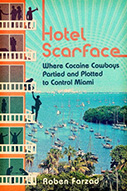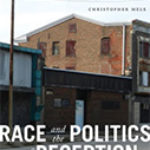Hotel Scarface: Where Cocaine Cowboys Partied And Plotted To Control

Author: Robin Farzad
Publisher: New York: New American Library, 2017. 352p.
Reviewer: Frederick T. Martens | March 2018
For those who lived through the 1960’s, 70’s and 80’s, the explosion of the drug scene throughout the United States marked a significant departure from prior decades. While heroin, marijuana, and to a lesser extent, cocaine were being marketed, they did not rival the scope and depth of the drug problem that had captured the post-sixties. Hotel Scarface presents a lurid, electrifying, and mind-boggling description of what it was like in the late 70’s and 80’s, when marijuana, cocaine and “crack,” a potent cocaine derivative, flooded the drug markets.
In some respects, I was fortunate to have had a bird’s eye view of these markets, having worked both as an undercover during this time period, and then later managing narcotics and organized crime detectives. One particular event stands out, that describes the glut of cocaine that hit the market and validates what was occurring in South Florida during the 80’s.
It was 1986, and a cocaine dealer attempted to sell one of my undercover agents a kilo of cocaine. We arranged for the transfer of money or what is commonly referred to as a “buy” to occur in a state police facility, camouflaging it as a radio station. Sure enough, the dealer walked into the building and presented me with a kilo of cocaine, while I was sitting at my desk. As was said then, it is easier having a kilo of cocaine delivered to your house than a pizza pie (See e.g., Pinsley, 1986).
The multitude of events and situations catalogued here by Farzad, represent just another wretched example in what former Secretary of State George Schultz has described as “a failed war on drugs” (NYT, December 31, 2017).
Farzad paints a picture of a Miami that was confronted with what has been labelled by criminologists as narco-terrorism. Miami clearly was a failed state, having succumbed to the unabated importation and distribution of massive amounts of cocaine and marijuana from Peru, Colombia and Mexico; systemic corruption at virtually every level of government; assassinations of drug dealers, competitors, and informants, some merely suspected; a heightened level of fear among the general populace that obscured community support for law enforcement; and the vast infusion of cash that some researchers contend “played a major role in saving the world financial system from collapse…” (Petras, 2016, pp. 269-273).
According to Farzad, “one-third of Miami’s economic output was derived from narcotics…” (Micolta, 2012; Farzad, p. 10). He contends that “so much marijuana was getting confiscated that Florida Power and Light was burning tons to run their generators…732 pounds of pot replaced a barrel of crude (oil)…The Federal Reserve branch in Miami was showing a five-billion-dollar surplus” (p. 11). “Cocaine was being promoted as the Dom Perignon of narcotics…” (p.29).
Of course, one should always question what may appear to be “imaginary numbers.” Nonetheless, if only half of what Farzad describes in this telling is accurate, the “rule of law” in this instance had been hijacked by criminal elements that seemed to be immune to its sanctions. Miami was a city under siege.
Farzad argues that the explosion of the drug culture was in large part a consequence of the historic Mariel boat flotilla and the unexpected and cynical release of prisoners from Cuban jails by Fidel Castro. “You have to realize that everything and everyone in Havana before and after Castro was for sale,”he contends (p. 60). But, scape-goating these newly-arrived immigrants for what was and is clearly an American demand issue, compounded by the lack of integrity on the part of American public servants, obscures the fact that the United States had and has one of the highest, if not the highest, rates of drug use in the world. As a consequence of the drug situation, violence in South Florida was at epidemic levels. Between 1978 and 1981, murders in Dade County alone rose from 243 to 621—a 255 per cent increase.
The author’s penchant for accenting the most violent and sensational aspects of the drug trade may be seen by some as sensationalism, and as presenting a distorted picture of the drug marketplace. His vignettes do, however, have enough solid and credible evidence to make this book a worthwhile contribution to criminological research. Moreover, the economic implications of the drug trade are thoroughly addressed, particularly with respect to the infusion of capital into those communities that had suffered from the “hard” times experienced in the 1980s.
For those who are interested in addressing any so-called “war on drugs” on a policy level, this book provides compelling evidence that unless and until demand is appropriately constrained, preferably through health-managed modalities, the supply side of the equation will never be contained. America’s insatiable appetite for mind-altering drugs will continue to allow for such criminal cartels, enterprises, networks, and entrepreneurs to enjoy the enormous profits that are a natural and predictable consequence of prohibition. History can and does provide lessons. Unfortunately, these lessons are too often ignored.
Patricia Micolta, “Illicit Interest Groups: The Political Impact of The Medellin Drug Trafficking Organizations in Columbia.” (2012). Florida International University.
James Petras and Henry Veltmeyer, Beyond Neo-Liberalism: A World to Win. (2016) London: Routledge.
Pinsley, Elliot. “Dial FM For Drug Arrest.” Bergen Record (Hackensack, N.J.). February 19, 1986.
George P. Schultz and Pedro Aspe. “The Failed War on Drugs.” The New York Times. December 31, 2017.
Frederick T. Martens is a past president of IASOC; has taught at The College of New Jersey and Penn State University; and retired from both the New Jersey State Police and the Pennsylvania Crime Commission, where he both managed narcotics and organized crime control efforts and performed in an undercover capacity.


